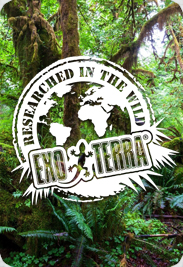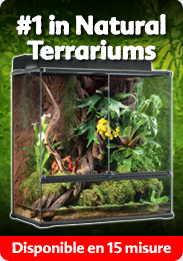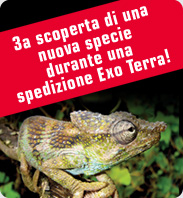Spedizione 2006 - Madagascar / Il diario
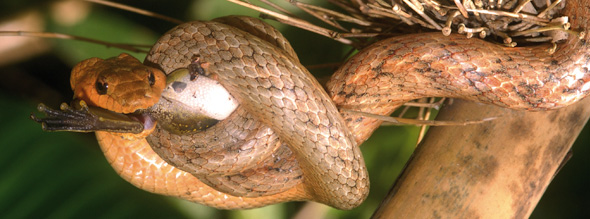
All members of the Exo Terra Expedition Madagascar 2006 returned home safely after three weeks of intense field research in the jungles and bamboo forests of North Western Madagascar.
After the discovery of a new species of day gecko (Phelsuma vanheygeni) by Exo Terra Manager Emmanuel Van Heygen in 2004 during the Exo Terra Expedition Madagascar 2004, many questions were left unanswered regarding the distribution range, behaviour and ecology of this remarkable discovery. In order to find answers to these questions the Exo Terra team returned to the area in June 2006.
Itinerary
Day 01 – June 6th : Brussels – Paris – Reunion
Day 02 – June 7th : Reunion – Nosy Bé (Madagascar)
Day 03 – June 8th : Ambatoloaka
Day 04 – June 9th : Nosy Komba - Ankify
Day 05 – June 10th : Ankify – Ampopo
Day 06 – June 11th : Ampopo – Bezavona
Day 07 – June 12th : Bezavona
Day 08 – June 13th : Bezavona
Day 09 – June 14th : Bezavona
Day 10 – June 15th : Bezavona – Nosy Iranja – Russian Bay
Day 11 – June 16th : Russian Bay – Ambaliha
Day 12 – June 17th : Ambaliha
Day 13 – June 18th : Ambaliha – Djangoa
Day 14 – June 19th : Djangoa
Day 15 – June 20th : Djangoa – Ambatoloaka
Day 16 – June 21st : Ambatoloaka – Mayotte (Comoro Islands)
Day 17 – June 22nd : Mayotte
Day 18 – June 23rd : Mayotte
Day 19 – June 24th : Mayotte – Lokobe (Nosy Bé)
Day 20 – June 25th : Lokobe – Reunion
Day 21 – June 26th : Reunion – Paris - Brussels
Ambatoloaka
On June 6, 2006 the Exo Terra Expedition team members met in Brussels Belgium to start the first leg of the Exo Terra Expedition 2006 to Madagascar. We first flew to Réunion Island where we had a connection the next day to Madagascar’s biggest offshore island Nosy Bé.
Our Malagasy team members and logistic support people picked us up at Fascene Airport, where we overloaded two small taxis to bring us to Ambatoloaka. Ambatoloaka is a small resort, located on the south-western coast of the island. When you arrive in Ambatoloaka, with the knowledge that it is Madagascar’s biggest tourist centre, you realize that Madagascar still has a long way to go to before it will make it into the mainstream travel brochures.
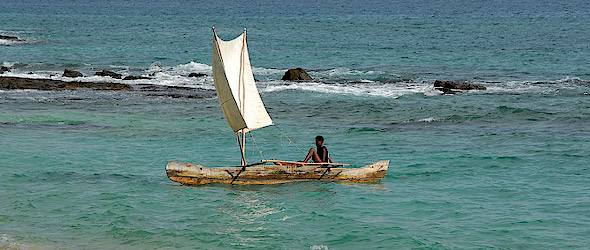
We checked in into our hotel for our last night of luxury. Most people would already consider staying in this hotel adventurous. It did not take long before we spotted our first day gecko, living on the ceiling of one of the rooms. The hotel is located right on the beach, where many locals changed profession when the first tourists started to arrive. Before, Ambatoloaka was a typical Malagasy fishing village. The many boats passing by prove that fishing is still the main source of income for many islanders. Many try to sell their catch to local restaurants or trade for other necessities.
We already bought some fruits and vegetables from local women, who offered their produce out of fully loaded baskets on top of their heads. Our local team would provide the rest of our supplies. Later that night we met with Monsieur Nazer, the chief of our local logistics team. He is very respected and set us up with his boat and a 60 horse power engine. We explained our plans and calculated how much fuel we should carry with us.
Tired from a long trip we were happy that the sun set around six at night, and not much later than that we all went to bed. The next morning after rising early, we loaded the boat and sailed to our first destination, Nosy Komba.
Nosy Komba
We arrived at this idyllic island around noon. Nosy Komba is Malagasy for Lemur Island, but this time we did not see any. We started our search for reptiles and amphibians right on the same beach where we landed, across from our next destination, Ankify. It did not take long before we spotted our first skinks, mainly Mabuya species, on some rocky outcrops on the beach. After photographing a very nice colored caterpillar, we found our first day geckos; a juvenile Phelsuma dubia, Phelsuma laticauda and Phelsuma madagascariensis grandis.

A short search in a nearby bamboo patch, where we hoped to find Phelsuma seippi and Phelsuma klemmeri did not reveal anything. We found Phelsuma seippi on the island in 2004, but never Phelsuma klemmeri.
On our way back to the boat, we spotted a panther chameleon, Furcifer pardalis. These panther chameleons are slightly different in coloration from those on Nosy Be and entirely different from those found elsewhere on Madagascar. We then sailed to Ankify, a trip of only 30 minutes.
Ankify
The Ankify Peninsula is situated in the Sambirano Delta and probably the terra typica of the day gecko Phelsuma klemmeri. Upon arrival we immediately organized a vehicle to bring us as close as possible to the bamboo forests in the peninsula’s interior. This would be the last car we would see for a while.
The first day gecko we discovered was Phelsuma seippi who normally shares its habitat with Phelsuma klemmeri. It did not take us long before we found our first Phelsuma klemmeri this trip, without doubt the most striking coloured gecko! Another species of day gecko present in these bamboo forests is Phelsuma laticauda.
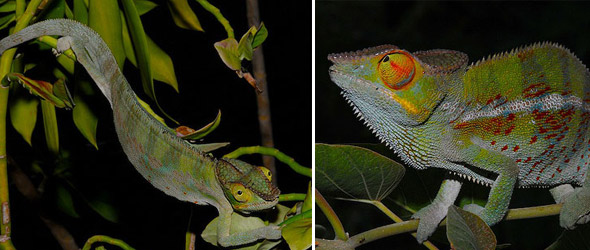
Madagascar has no real poisonous snakes, the only exception is the Malagasy hognose snake, Leioheterodon madagascariensis. While measuring one of these large snakes, team member Achim called for help, since he spotted another Phelsuma klemmeri nearby. We had to temporary put the snake in a backpack.
We caught several Phelsuma klemmeri for measuring and collecting of other data. Catching these little geckos that fit in the tiniest bamboo crack is not an easy task. You need more than one pair of eyes in order to finally capture them. It was remarkable how many species of one genus occurred in this area. Next to the giant Phelsuma madagascariensis grandis, we hoped to also find one of the smallest species, Phelsuma vanheygeni. This species was discovered by Exo Terra manager Emmanuel Van Heygen during the 2004 Madagascar Expedition.
When exploring the nearby forest we encountered the largest chameleon of Madagascar, Furcifer oustaleti. The body of this animal had the size of my underarm.
The peninsula has also its own colour morph of panther chameleon, Furcifer pardalis. Several males were found in a small area, but no females where sighted.
To make it before dark we had to leave Ankify for Ampopo, which is located onthe western side of the Ampasindava Peninsula. When we approached the shoreline where our boat was waiting, a group of dolphins passed very close to us, clearly hunting. In Ampopo we would just spend the night and then continue to Bezavona. It was a long trip of nearly 50 km and we had to refuel at sea from our fuel reserve.
Ampopo
In late afternoon we arrived near the small village of Ampopo, situated on a several kilometer-long stretch of pristine beach with the lowland forests immediately behind it. We set up camp right on the beach to better enjoy the cooler sea breezes and made a huge campfire to keep the mosquitoes and bush pigs away from our campsite. That night we discussed the strategy for the upcoming days, and afterwards some team members ventured into the nearby forest without much success.
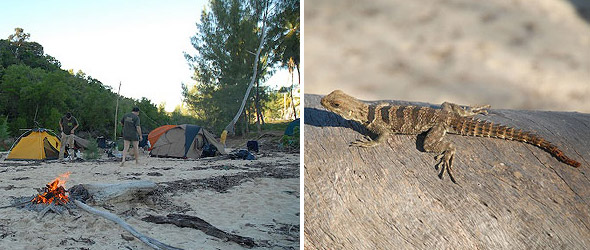
The next morning, even before sunrise, we immediately prepared for our boat trip to Bezavona, in the southern part of the Ampasindava Peninsula. The morning sunshine revealed the true beauty of this desolate spot, which made it all that much harder to pack the gear and leave. Out of the blue, a Malagasy hognose snake, Leioheterodon madagascariensis crawled through our campsite towards the nearby forest, where it disappeared as swiftly as it came. While following the snake we found our first Panther Chameleon, Chameleo pardalis.
This discovery exceeded everyone’s expectations as this was the much talked about Pink Panther, a colour morph thought to be found only near Ankaramy, south of Ambanja. It was a young male that did not yet have the splendid pinkish-red adult colouration. With this discovery we extended the known distribution range of this race of panther chameleon considerably, as it now sure that it inhabits the entire Ampasindava Peninsula.
At the edge of the forest and the beach several endemic orchids of the genus Angreacum were blooming. It was a very interesting spot that we sadly had to leave to make it in time to Bezavona.
Bezavona
It took us about three hours to reach the entrance of the Bezavona River in the southern part of the Ampasindava Peninsula. After we found the right river mouth, we went as far as possible up river, through dense mangrove forests, until there was not enough water to support our boat.
The villagers, who were curious what these “Vaza” (Malagasy for white people), were up to came to greet us. One of our Malagasy team mates told us that the last time they saw “Vaza” was about twenty-five years ago, when the last of the French abandoned the last vanilla plantation in the area. Thus, most villagers under 25 had never seen a white person.
After we erected our tents we discussed our plans for the next couple of days, since we planned to stay in this area for several days. The next morning we set up pitfall traps for smaller ground dwelling reptiles and amphibians in a nearby forest. The only animal we would catch in these was a small type of frog.
Immediately upon entering the bamboo forests surrounding our camp, we found Phelsuma vanheygeni. This species was discovered during our previous Exo Terra expedition in 2004 and was named after Exo Terra Manager Emmanuel Van Heygen. The gecko was sitting about 1 cm underneath a cicada-like insect, as if it was waiting for it to move.
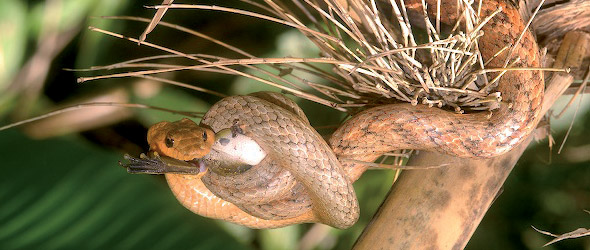
A little further we also discovered a Phelsuma seippi with the same behaviour, positioned right under another type of insect. The next bamboo pole also had a Phelsuma seippi on it, again with an insect right above it. It was clear that the geckos were not stalking the insects in order to eat them, but were waiting for them to excrete something. Even Phelsuma klemmeri was found exactly underneath an insect while two ants were trying to approach to feast as well on the probably sweet excretion from the insect, but had to wait for the Phelsuma klemmeri to leave. In addition to day geckos of the genus Phelsuma we also encountered several unknown Lygodactylus species.
Phelsuma seippi was definitely the most abundant of all the geckos inhabiting the bamboo forest. Also the Phelsuma vanheygeni seems to be very common in this area but is a bit more difficult to spot since it lives more between the bamboo leaves and thinner branches. One bamboo is usually the territory of a pair. During the day they move through the denser upper part of the bamboo and venture only seldom onto the thicker stem. They probably sleep in the dense leaves during the night.
We also scanned the forests near the campsite for chameleons. The first one we encountered was a massive Furcifer oustaleti. It is abundant and widespread in Madagascar and inhabits both warm and humid coastal lowlands but seems to prefer drier forests. This large chameleon commonly reaches a total length of 60 cm but even larger males have been reported. Coloration is primarily of grays and browns but also completely green animals were found. Females tend to be slightly more colourful than males, as well as somewhat slimmer and slightly smaller.
Another abundant species in the area is Furcifer pardalis. Females are hard to classify as to a specific colour morph, while in males this variance of coloration is more noticeable. Probably it is a “Pink Panther” colour morph, since Ankaramy is only about 20 km east of Bezavona. Adult males, in addition to being significantly, larger have a more defined casque.
A know predator of smaller lizards and amphibians is the snake, Ithycyphus miniatus which we found in a bamboo patch eating a frog right before our eyes (and camera).
We could smell the scent of delicious food while heading back to our camp. Nazir was already preparing a great dinner, He was able to get some potatoes in the village and was making French fries. The ever present and curious villagers watched their version of “Emeril Live!” The “Chef de Village” or village chief joined us for dinner that afternoon and listened in on how we prepared for the next day.
After sunset we looked again for everything that crept, leaped and crawled. The first creature to catch our attention was a colossal spider waiting for an insect to make a mistake while the greater hedgehog tenrec, Setifer setosus, common over much of Madagascar was looking for fruits and insects on the forest floor.
In the trees several geckos of the genus Geckolepis, or fish scaled geckos, were spotted. These are easily recognizable by their large scales, which are fixed only superficially. These geckos are active during the night and spend the day under the bark of trees in primary or secondary forests.
The endemic genus of Uroplatus is also nocturnal but relies on its camouflage and spends the day head downward on small trees. At night they hunt for insects and sometimes jump more than a meter from tree to tree.
We prepared now to head back to the river where our boat was waiting. Hopefully it was already high tide since we had a long journey through the mangroves ahead of us. Some villagers who came to the riverbank to say goodbye accompanied us. Luckily there was already sufficient water to take us too the open sea. The high tide covered many sandbanks and mangrove scrub so we relied on local fishermen to guide us through this underwater labyrinth.
We first headed for Nosy Iranja, a small island off the coast of the Ampasindava Peninsula. Nosy Iranja is made up of two islands conjoined by a bank of white sand, which is submerged at high tide. We were able to pick up the supplies, mainly fuel and water, that were brought here from our base at Nosy Be.
On the island we spotted a Madagascar Coucal, Centropus toulou, which we also observed in several bamboo forests on the peninsula. It was eating a Phelsuma laticauda, which confirmed our suspicion that this bird is a major Phelsuma predator. We left Nosy Iranja for Russian Bay at the Northern part of the Ampasindava Peninsula to spend the night.
Ambaliha
The bay’s name dates back to an incident in 1905, during the Russo-Japanese war. A Russian warship anchored here with orders to attack any passing Japanese ships, but the crew tasted the sweet life in Madagascar. The crew had barely raised a mutiny before their officers gave in, have taken a look at the lovely Malagasy women. The ship was hidden in what is now called Russian Bay and only emerged to trade with pirate vessels in the Mozambique Channel. The Russians sold anything they could remove from the ship and the last Russian died in 1936. The remains of the wreck can still be seen at low tide.
Just before leaving this Garden of Eden we spotted a juvenile Madagascar Iguana, Oplurus cuvieri, basking on a palm trunk. This disjointed distribution of iguanas is a bio-geographic mystery. The whole family consists of 650 species, of which 99% occurs in the Americas, with only very few species occuring elsewhere in Fiji, Tonga and Madagascar.
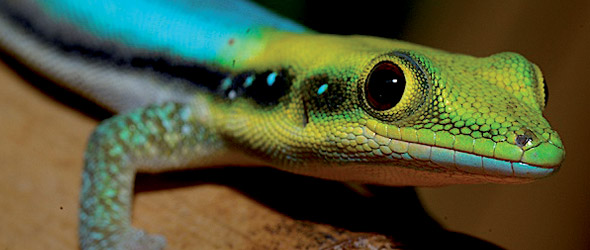
We now set course to Ambaliha, one of the major villages on the Eastern side of the Ampasindava Peninsula. After traveling several kilometres upstream we had to leave the boat behind. Unfortunately it was low tide and we had to walk the last couple of kilometres. Like last visit in 2004 we chose the only store in the village as our base, and we were able to leave behind some unnecessary gear as well as the outboard engines behind.
Ambaliha is a typical Malagasy village with extremely friendly people that are ever curious and inquisitive. We showed one of the children in the village pictures on my iPod of her father that we took in 2004 when he went into the forest with us. Needless to say the entire village was amazed to see some of the villagers on this little iPod-screen.
After a brief stop at the “Chef the Village’s” office to ask permission to go into the mountains, we were finally able to start our ascent. The views were spectacular; in the distance you can see Ankify, Nosy Komba and even the Lokobe Strict Reserve on the island of Nosy Bé.
After a strenuous climb, it was already dark when we arrived at the top of the mountain and were able to erect our camp. Some of the guys carrying part of our equipment went down again to bring up the next load. We were full admiration that they did this exhausting trip twice, carrying the heavy bags, generator and cases, and barefoot.
The next morning we were all well rested and prepared for the next journey downhill on the other side of the mountain into the bamboo forest. A small source nearby provided us with fresh drinking water. Our clothes need a wash too after several days in the jungle, Nazir took care of this while we explored the environment. On the way down we met many people, all carrying something. This was a major trading path, where people from the inland region traded wood and rice for fish with the villagers from the coastal area.
High in these mountains most of the forest is still intact and wildlife is still abundant. We found many animals in a short span of time, such as plated lizards, snakes and even leaf-tailed geckos. The Madagascar plated lizard, Zonosaurus madagascariensis, is very common on the peninsula. Dromicodryas bernieri is a mainly terrestrial and diurnal snake with a round pupil. Madagascarophis colubrius on the contrary is a nocturnal species with a clearly vertical pupil. This species of the genus Madagascarophis are among the most common Malagasy snakes. They are mostly terrestrial but can often be found climbing. Frogs, skinks, geckos, chameleons and also snakes and birds are among the prey items.
Uroplatus henkeli is actually widespread, although they generally have fragmented ranges. Uroplatus species or Leaf-tailed Geckos are very distinctive lizards and endemic to Madagascar. They are nocturnal and found in a range of forest habitats. All species are undoubtedly affected by ongoing forest loss in Madagascar. Whilst some species can apparently tolerate some degree of habitat degradation, they are reportedly generally found in secondary habitats in low densities only.
Once we reached the bamboo forests, we were again stunned by the density of day geckos. In the internal bamboo forests of the Ampasindava peninsular, Phelsuma vanheygeni is very common. It shares its habitat with Phelsuma klemmeri, Phelsuma seippe, Phelsuma laticauda and the bigger Phelsuma madagascariensis grandis. Phelsuma vanheygeni is one of the smaller day gecko species that is well adapted to living in bamboo. It is a taxonomically isolated species and has no closely related species within the genus.
Also here we found Furcifer pardalis, the typical color morph on the Ampasinadava Peninsula, the Pink Panther. Spectacular color variations and subtle shape variations of the head in males in specific populations seem to exhibit a gradient between different regions and have been used to differentiate areas of origin. Subspecies have not been formally defined but more detailed study including genetic variation may reveal distinct populations in the near future. The Panther Chameleon is indigenous to the warm and humid regions of northern, north-western, north-eastern, and eastern Madagascar. It is one of the most common species on Madagascar. Cuvier first described this highly sexually dimorphic species in 1829. The larger mature males can reach a total body length of up to 50 cm.
In the vicinity of a small brook we discovered a Paroedura oviceps. In contrast to most Malagasy geckos, Paroedura species lead a mainly terrestrial life. It is a nocturnal gecko spending the daytime hours under bark of dead trees.
The descent back to the coast was somewhat easier, probably facilitated by the spectacular view. When we arrived back near the village, the water was already so high that we had to walk through several tidal creeks to reach the boat with all the gear. Through the mangroves we set course to cross the Ampasinadava bay towards the town of Djangoa.
Djangoa
When we arrived at the Djangoa River, the water was already withdrawing rapidly, making it difficult to go upstream. Finally we found ourselves stranded at Djangoa, a town where the “Route National 6”, one of Madagascar’s main roads, crosses the Djangoa River. Djangoa is a small town with a mosque and many other stone buildings. People are, as everywhere in Madagascar, helpful and friendly. One family even invited us even to see their tamed pet black lemur. Somewhat sad, but apparently the animal, a Eulemur macaco, was well taken care of.
We crossed the river over the bridge to set up camp on the northern bank of the river, near a bamboo forest. On the riverbank we found a juvenile mud turtle, Pelusios castanoides. Although crocodiles were common according to the villagers, the river offered great refreshment and an opportunity to wash off days of jungle dirt and sweat. This campsite was definitely the best so far.
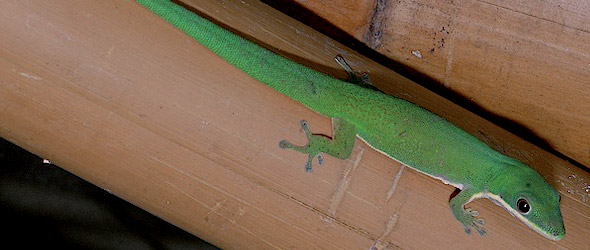
The highlight of this expedition was definitely the discovery of Phelsuma vanheygeni in the bamboo forests here. This is the first record of these recently discovered day geckos off of the Ampasindava Peninsula and so close to a main road, a road that has been used by many researchers on their way to Ambanja or Antananarivo. It was a very dense and healthy population since we recorded several specimens in a relatively short timespan. Phelsuma klemmeri could not be found here.
Near the campsite another Furcifer pardalis was sighted and again it was the “Pink Panther” or Ankaramy morph. The original location of this colour morph, Ankaramy, is just 30 km further to the south on the RN 6. Only one young male was found.
While examining a dead tree we found several beetles. Two of them were a pair of mating mango tree borers, Batocera rufomaculata. The beetles are considered a pest in many tropical countries since they lay their eggs in fruit trees like mango trees. The damage is caused by the grub of this beetle as it feeds inside the stems boring upward, resulting in branches dying. In severe cases the stem also dies. On the same tree we also documented a Geckolepis maculata which we tried to chase out of its hiding place.
While loading our equipment in the boat, we spotted a Zonosaurus laticaudatus basking on the riverbank. A little further on we caught an impressive Hoplobatrachus tigerinus. This giant semi-aquatic frog measuring 170 mm, is the only frog that is not native to Madagascar. It was introduced by the Chinese in the Mahajanga region, the exact origin of the frogs is unknown.
We now sailed back full speed to Ambatoloaka on Nosy Bé. The next day we had to catch a plane to the Comoro Island, Mayotte. Entering the airport, and an airplane was an abrupt end to our weeks in the uncivilized jungles of the Ampasindava Peninsula.
Mayotte
Mayotte is geographically the oldest of all four Comoro Islands and has very distinct flora and fauna. We were greeted by a group of brown lemurs, Eulemur fulvus mayottensis, upon arrival in our camp in the south of the island near Kani Kely. Brown lemurs live in social groups of up to 30 individuals. The groups are unstable as individuals freely circulate throughout groups every day. Brown lemur groups are unusually peaceful internally, with little or no dominance hierarchy and little dominance of females toward males. The diet consists mostly of fruit, young leaves, and flowers.
Soon we found ourselves again in the bamboo forests looking for two of the endemic species of Phelsuma living in this type of habitat. The bamboo on Mayotte is much denser, thicker and taller than the one on Madagascar. After a thorough search we discovered a young Phelsuma v-nigra pasteuri male. Phelsuma v-nigra can be recognized by the blue spot on the neck. In the same bamboo patch we found after continuous efforts several specimens of Phelsuma nigistriata, another Mayotte endemic. Mayotte is one of few the islands outside Madagascar where also the Phelsuma laticauda laticauda also occurs. There are no morphological differences between the animals of Nosy Bé and the Ampasindava Peninsula.
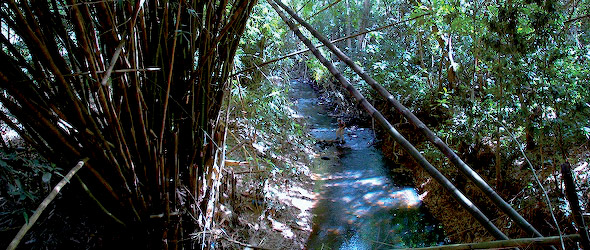
We saw near the bamboo forest some Pteropus seychellensis comorensis, a native fruit bat that usually roosts in groups but forages for fruits individually. The fruit bats on Mayotte are becoming very rare.
The only chameleon species on Mayotte was discovered near the bamboo forest as well. Furcifer polleni belongs to the smaller chameleon species and is closely related to the other Comoro species, Furcifer cephalolepis, and to the Malagasy species, Furcifer pardalis. The males reach a total length of about 20 c mand females remain clearly smaller with at about 15 cm. Females are often more colourful, but also their basic coloration is green. These chameleons are extremely aggressive towards other chameleons.
We were also able to locate the other endemic day gecko species of Mayotte, Phelsuma robertmertensi. It is probably the most widespread of all endemic Phelsuma species on Mayotte. The animals are not often found in the coastal regions. Phelsuma robertmertensi occurs mostly on leaf trees like those found in the many citrus plantations and along streams where line fragments of indigenous forests can be found. We also found them licking the excretion at the end of the branches of a Frangipani tree. During daytime the animals can often be found basking on sun exposed tree trunks. Several males and females can be found on one tree, depending on the size of the tree.
We left Mayotte for our last research area on Nosy Bé, Lokobe Forest. After an hours flight we arrive back on Nosy Bé Island where we immediately head for Lokobe Forest on the southeastern tip of the island.
Lokobe
Lokobe is a strict reserve that enjoys the highest grade of protection. We entered the forest from the eastern side, an area that is only accessible by boat.
It was here we found our first Madagascar ground boa, Acrantophis madagascariensis. This is the largest of any Malagasy snakes, they can get up to three and a half meters. In Madagascar only boidea, or boas occur, whereas on the African mainland mainly Pythonidae, or Pythons occur. It is a similar situation as with the Iguanidae since the distribution of Boas is mainly Central and South America. The Malagasy Boas are closely related to the New World species like Boa constrictor. Acrantophis madagascariensis is ovoviviparous or gives birth to live young.
Above our heads a group of black lemurs were feeding on leaves and fruits. Black lemurs are limited to the north-western tip of Madagascar and the two adjacent islands of Nosy Komba and Nosy Bé. There is striking sexual dimorphism in colour, males are entirely black whereas female black lemurs have a dark coat which lightens to a deep rust on the sides and off-white on the stomachs. Black lemurs are social, living in groups of between 2 to 15 related individuals. A major predator of these lemurs is definitely an Acrantophis madagascariensis.

On a tree trunk we spotted a Zonosaurus rufipes, this plated lizard is only known in the Sambirano forest regions. It is a typical forest species that is often found near brooks and small rivers in the Lokobe Forest. Since we visited Lokobe in the dry season we did not encounter many frogs. One of the few was this Boophis species near a small stream.
On a small twig a clearly gravid female with a regenerating tail of Paroedura stumpffi was discovered. This species is mainly found on the ground or in low scrub on the forest floor in primary forest areas. Geckolepis maculata is also very common in the Lokobe forest. It can be found mostly on trees with loose bark that offers ideal hiding spaces during the day.
The park is bordered by a pristine beach in the extreme south of Nosy Bé Island. Some small bungalows were built here for visitors to Lokobe Forest. It was the ideal spot to recharge our batteries after the extensive research weeks in the Malagasy jungle.
This expedition answered many questions when it comes to the behaviour and ecology of many reptile and amphibian species. Many are left unanswered, so further research is necessary… we will be back.


